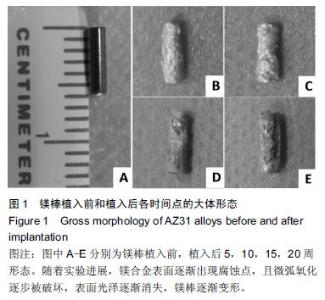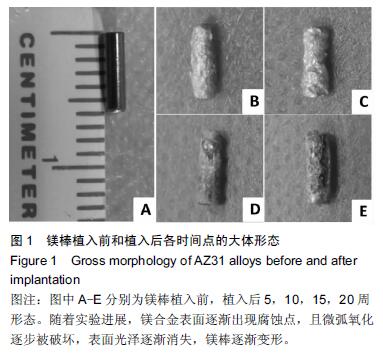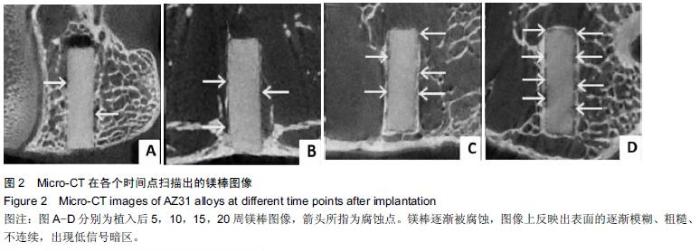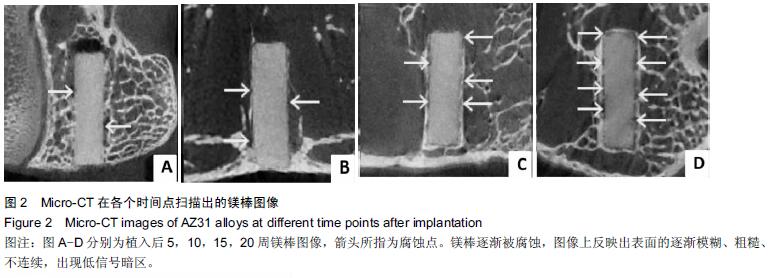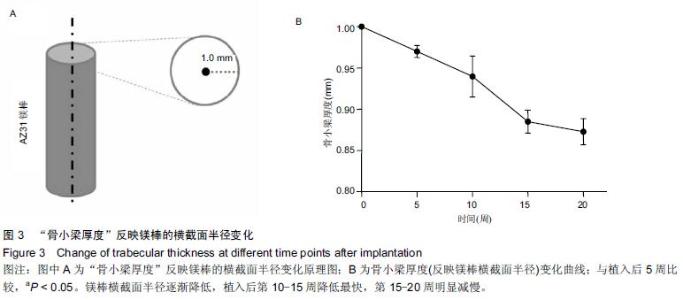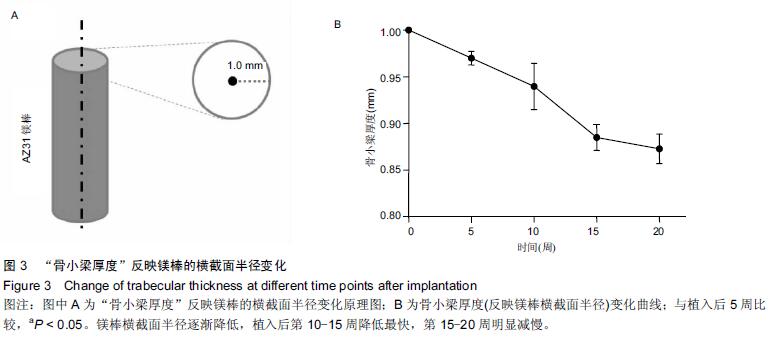Chinese Journal of Tissue Engineering Research ›› 2016, Vol. 20 ›› Issue (16): 2303-2309.doi: 10.3969/j.issn.2095-4344.2016.16.003
Previous Articles Next Articles
Degradation of AZ31 magnesium alloys in vivo: micro-CT assessment
Xu Yi-chi, Yin He-yong, Sun Zhen, Meng Hao-ye, Xiao Bo, Wang Ai-yuan, Guo Quan-yi, Peng Jiang, Lu Shi-bi
- Institute of Orthopaedics of Chinese PLA General Hospital, Beijing Key Laboratory of Orthopedic Regenerative Medicine (No. BZ0128), Key Laboratory of Musculoskeletal Trauma & War Injuries of PLA, Beijing 100853, China
-
Received:2016-03-06Online:2016-04-15Published:2016-04-15 -
Contact:Lu Shi-bi, Academician, Professor, Chief physician, Doctoral supervisor, Institute of Orthopaedics of Chinese PLA General Hospital, Beijing Key Laboratory of Orthopedic Regenerative Medicine (No. BZ0128), Key Laboratory of Musculoskeletal Trauma & War Injuries of PLA, Beijing 100853, China -
About author:Xu Yi-chi, Studying for master’s degree, Institute of Orthopaedics of Chinese PLA General Hospital, Beijing Key Laboratory of Orthopedic Regenerative Medicine (No. BZ0128), Key Laboratory of Musculoskeletal Trauma & War Injuries of PLA, Beijing 100853, China -
Supported by:the National Natural Science Foundation of China, No. 51361130034; the National Key Basic Research Development Program of China (973 Program), No. 2012CB518106; Twelfth Five-Year Development Plan of PLA, No. BWS11J025; the Natural Science Foundation of Beijing, No. Z141107004414044
Cite this article
Xu Yi-chi, Yin He-yong, Sun Zhen, Meng Hao-ye, Xiao Bo, Wang Ai-yuan, Guo Quan-yi, Peng Jiang, Lu Shi-bi. Degradation of AZ31 magnesium alloys in vivo: micro-CT assessment[J]. Chinese Journal of Tissue Engineering Research, 2016, 20(16): 2303-2309.
share this article
| [1] Staiger MP, Pietak AM, Huadmai J, et al. Magnesium and its alloys as orthopedic biomaterials: a review. Biomaterials. 2006;27(9):1728-1734.
[2] 谢兴文,黄晋,李宁,等.镁及镁合金植入体在骨科临床中的应用与进展[J].中国组织工程研究, 2012,16(39): 7317-7321.
[3] Han P, Tan M, Zhang S, et al. Shape and site dependent in vivo degradation of Mg-Zn pins in rabbit femoral condyle. Int J Mol Sci. 2014;15(2):2959-2970.
[4] Ratna Sunil B, Sampath Kumar TS, Chakkingal U, et al. In vitro and in vivo studies of biodegradable fine grained AZ31 magnesium alloy produced by equal channel angular pressing. Mater Sci Eng C Mater Biol Appl. 2016;59:356-367.
[5] Lindtner RA, Castellani C, Tangl S, et al. Comparative biomechanical and radiological characterization of osseointegration of a biodegradable magnesium alloy pin and a copolymeric control for osteosynthesis. J Mech Behav Biomed Mater. 2013;28:232-243.
[6] 王树峰,李春荣,王程越,等.微弧氧化AZ31镁合金的生物相容性[J].中国组织工程研究, 2012,16(38): 7101-7106.
[7] Kraus T, Fischerauer SF, Hänzi AC, et al. Magnesium alloys for temporary implants in osteosynthesis: in vivo studies of their degradation and interaction with bone. ActaBiomater. 2012;8(3):1230-1238.
[8] 薛静,彭江,汪爱媛,等.活体小动物Micro-CT动态评价大鼠股骨牵张成骨[J].中国矫形外科杂志,2010,(9): 752-758.
[9] 彭江,汪爱媛,孙明学,等.Micro-CT在松质骨结构研究中的应用[J].中国矫形外科杂志,2005,(11):859-861.
[10] Fischerauer SF, Kraus T, Wu X, et al. In vivo degradation performance of micro-arc-oxidized magnesium implants: a micro-CT study in rats. Acta Biomater. 2013;9(2):5411-5420.
[11] Schambach SJ, Bag S, Schilling L, et al. Application of micro-CT in small animal imaging. Methods. 2010; 50(1):2-13.
[12] Clark DP, Badea CT. Micro-CT of rodents: State-of-the-art and future perspectives. Phys Med. 2014;(30):619-634.
[13] 张涛,武肖娜,尹庆水,等.镁合金AZ31B材料表性与成骨细胞的黏附[J].中国组织工程研究,2013,17(12): 2123-2130.
[14] 齐峥嵘,张强,殷毅,等.可降解镁合金作为骨植入材料的体内研究进展[J].中国修复重建外科杂志,2012,26(11): 1381-1386.
[15] Grünewald TA, Ogier A, Akbarzadeh J, et al. Reaction of bone nanostructure to a biodegrading Magnesium WZ21 implant: a scanning small-angle X-ray scattering time study. Acta Biomater. 2015.
[16] Brooks EK, Der S, Ehrensberger MT. Corrosion and mechanical performance of AZ91 exposed to simulated inflammatory conditions. Mater Sci Eng C Mater Biol Appl. 2016;60:427-436.
[17] Witte F. The history of biodegradable magnesium implants: a review. Acta Biomater. 2011;6:1680-1692.
[18] Walker J, Shadanbaz S, Woodfield TB, et al. Magnesium biomaterials for orthopedic application: a review from a biological perspective. J Biomed Mater Res B Appl Biomater. 2014;102(6):1316-1331.
[19] Vladimirov BV, Krit BL, Lyudin VB, et al. Microarc oxidation of magnesium alloys: a review. Surface Eng App Electrochem. 2014;50(3):195-232.
[20] 张佳,宗阳,付彭怀,等.镁合金在生物医用材料领域的应用及发展前景[J].中国组织工程研究与临床康复,2009, 13(29):5747-575.
[21] Zhen Z, Liu XL, Huang T, et al. BHemolysis and cytotoxicity mechanisms of biodegradable magnesium and its alloys. Mater Sci Eng C Mater Biol Appl. 2015; 46:202-206.
[22] Pompa L, Rahman ZU, Munoz E, et al. Surface characterization and cytotoxicity response of biodegradable magnesium alloys. Mater Sci Eng C Mater Biol Appl. 2015;49:761-768.
[23] Wang DW, Cao Y, Qiu, H, et al. Improved blood compatibility of Mg-1.0Zn-1.0Ca alloy by micro-arc oxidation. J Biomed Mater Res A. 2011;99(2):166-172.
[24] Zhang EL, Xu LP, Yu GN, et al. In vivo evaluation of biodegradable magnesium alloy bone implant in the first 6 months implantation. J Biomed Mater Res A. 2009;90(3):882-893.
[25] Schillinga T, Brandesa G, Tudorache I, et al. In vivo degradation of magnesium alloy LA63 scaffolds for temporary stabilization of biological myocardial grafts in a swine model. Biomed Tech (Berl). 2013;58(5): 407-416.
[26] Seitz JM, Eifler R, Bach FW, et al. Magnesium degradation products: effects on tissue and human metabolism. J Biomed Mater Res A. 2014;102(10): 3744-3753.
[27] Chen YJ, Xu ZG, Smith C, et al. Recent advances on the development of magnesium alloys for biodegradable implants. Acta Biomater. 2014;10(11): 4561-4573.
[28] Waizy H, Diekmann J, Weizbauer A, et al. In vivo study of a biodegradable orthopedic screw (MgYREZr-alloy) in a rabbit model for up to12months. J Biomater Appl. 2014;28(5):667-675.
[29] Clark DP, Badea CT. Micro-CT of rodents: State-of-the-art and future perspectives. Physica Medica.2014;(30):619-634.
[30] Vanderoost J, Harry van GL. From histology to micro-CT: measuring and modeling resorption cavities and their relation to bone competence. World J Radiol. 2014;6(9):643-656.
[31] Zhao D, Wang T, Kuhlmann J, et al. In vivo monitoring the biodegradation of magnesium alloys with an electrochemical H2 sensor. Acta Biomater. 2016.
[32] Schaller B, Saulacic N, Imwinkelried T, et al. In vivo degradation of magnesium plate/screw osteosynthesis implant systems: Soft and hard tissue response in a calvarial model in miniature pigs. J Craniomaxillofac Surg. 2016;44(3):309-317.
[33] Meininger S, Mandal S, Kumar A, et al. Strength reliability and in vitro degradation of three-dimensional powder printed strontium-substituted magnesium phosphate scaffolds. Acta Biomater. 2016;31:401-411.
[34] Durisin M, Reifenrath J, Weber CM, et al. Biodegradable nasal stents (MgF2 -coated Mg-2 wt % Nd alloy)-A long-term in vivo study. J Biomed Mater Res B Appl Biomater. 2015.
[35] Ikeo N, Nakamura R, Naka K, et al. Fabrication of a magnesium alloy with excellent ductility for biodegradable clips. Acta Biomater. 2016;29:468-476. |
| [1] | Zhang Tongtong, Wang Zhonghua, Wen Jie, Song Yuxin, Liu Lin. Application of three-dimensional printing model in surgical resection and reconstruction of cervical tumor [J]. Chinese Journal of Tissue Engineering Research, 2021, 25(9): 1335-1339. |
| [2] | Chen Xinmin, Li Wenbiao, Xiong Kaikai, Xiong Xiaoyan, Zheng Liqin, Li Musheng, Zheng Yongze, Lin Ziling. Type A3.3 femoral intertrochanteric fracture with augmented proximal femoral nail anti-rotation in the elderly: finite element analysis of the optimal amount of bone cement [J]. Chinese Journal of Tissue Engineering Research, 2021, 25(9): 1404-1409. |
| [3] | Du Xiupeng, Yang Zhaohui. Effect of degree of initial deformity of impacted femoral neck fractures under 65 years of age on femoral neck shortening [J]. Chinese Journal of Tissue Engineering Research, 2021, 25(9): 1410-1416. |
| [4] | Chen Junming, Yue Chen, He Peilin, Zhang Juntao, Sun Moyuan, Liu Youwen. Hip arthroplasty versus proximal femoral nail antirotation for intertrochanteric fractures in older adults: a meta-analysis [J]. Chinese Journal of Tissue Engineering Research, 2021, 25(9): 1452-1457. |
| [5] | Zeng Yanhua, Hao Yanlei. In vitro culture and purification of Schwann cells: a systematic review [J]. Chinese Journal of Tissue Engineering Research, 2021, 25(7): 1135-1141. |
| [6] | Cai Qunbin, Zou Xia, Hu Jiantao, Chen Xinmin, Zheng Liqin, Huang Peizhen, Lin Ziling, Jiang Ziwei. Relationship between tip-apex distance and stability of intertrochanteric femoral fractures with proximal femoral anti-rotation nail: a finite element analysis [J]. Chinese Journal of Tissue Engineering Research, 2021, 25(6): 831-836. |
| [7] | Xu Dongzi, Zhang Ting, Ouyang Zhaolian. The global competitive situation of cardiac tissue engineering based on patent analysis [J]. Chinese Journal of Tissue Engineering Research, 2021, 25(5): 807-812. |
| [8] | Liu Jiangfeng. Nano-hydroxyapatite/polyamide 66 composite filling combined with locking plate in the treatment of fibrous dysplasia of femoral bone [J]. Chinese Journal of Tissue Engineering Research, 2021, 25(4): 542-547. |
| [9] | Wu Zijian, Hu Zhaoduan, Xie Youqiong, Wang Feng, Li Jia, Li Bocun, Cai Guowei, Peng Rui. Three-dimensional printing technology and bone tissue engineering research: literature metrology and visual analysis of research hotspots [J]. Chinese Journal of Tissue Engineering Research, 2021, 25(4): 564-569. |
| [10] | Chang Wenliao, Zhao Jie, Sun Xiaoliang, Wang Kun, Wu Guofeng, Zhou Jian, Li Shuxiang, Sun Han. Material selection, theoretical design and biomimetic function of artificial periosteum [J]. Chinese Journal of Tissue Engineering Research, 2021, 25(4): 600-606. |
| [11] | Liu Fei, Cui Yutao, Liu He. Advantages and problems of local antibiotic delivery system in the treatment of osteomyelitis [J]. Chinese Journal of Tissue Engineering Research, 2021, 25(4): 614-620. |
| [12] | Li Xiaozhuang, Duan Hao, Wang Weizhou, Tang Zhihong, Wang Yanghao, He Fei. Application of bone tissue engineering materials in the treatment of bone defect diseases in vivo [J]. Chinese Journal of Tissue Engineering Research, 2021, 25(4): 626-631. |
| [13] | Zhang Zhenkun, Li Zhe, Li Ya, Wang Yingying, Wang Yaping, Zhou Xinkui, Ma Shanshan, Guan Fangxia. Application of alginate based hydrogels/dressings in wound healing: sustained, dynamic and sequential release [J]. Chinese Journal of Tissue Engineering Research, 2021, 25(4): 638-643. |
| [14] | Chen Jiana, Qiu Yanling, Nie Minhai, Liu Xuqian. Tissue engineering scaffolds in repairing oral and maxillofacial soft tissue defects [J]. Chinese Journal of Tissue Engineering Research, 2021, 25(4): 644-650. |
| [15] | Nie Shaobo, Li Jiantao, Sun Jien, Zhao Zhe, Zhao Yanpeng, Zhang Licheng, Tang Peifu. Mechanical stability of medial support nail in treatment of severe osteoporotic intertrochanteric fracture [J]. Chinese Journal of Tissue Engineering Research, 2021, 25(3): 329-333. |
| Viewed | ||||||
|
Full text |
|
|||||
|
Abstract |
|
|||||
